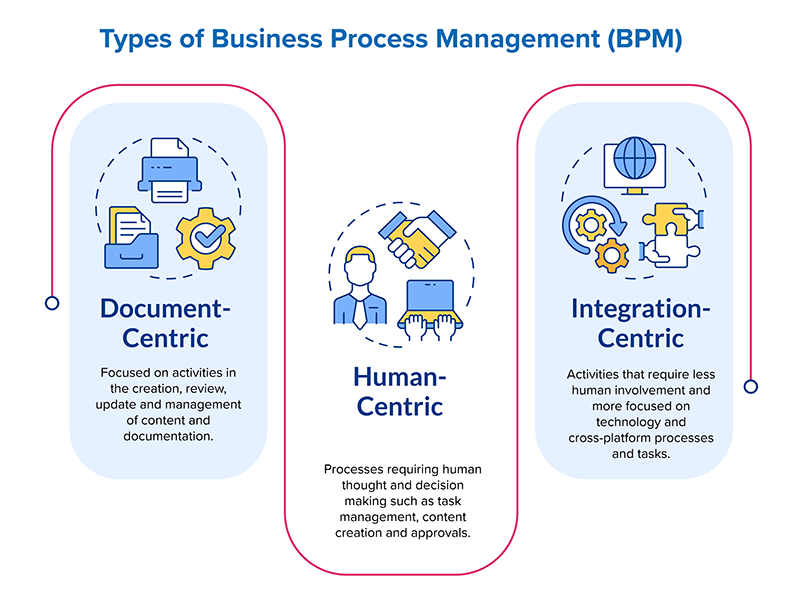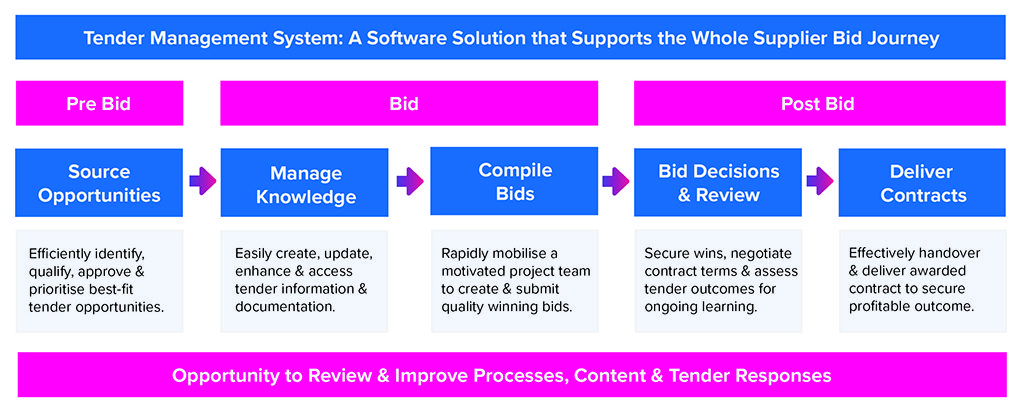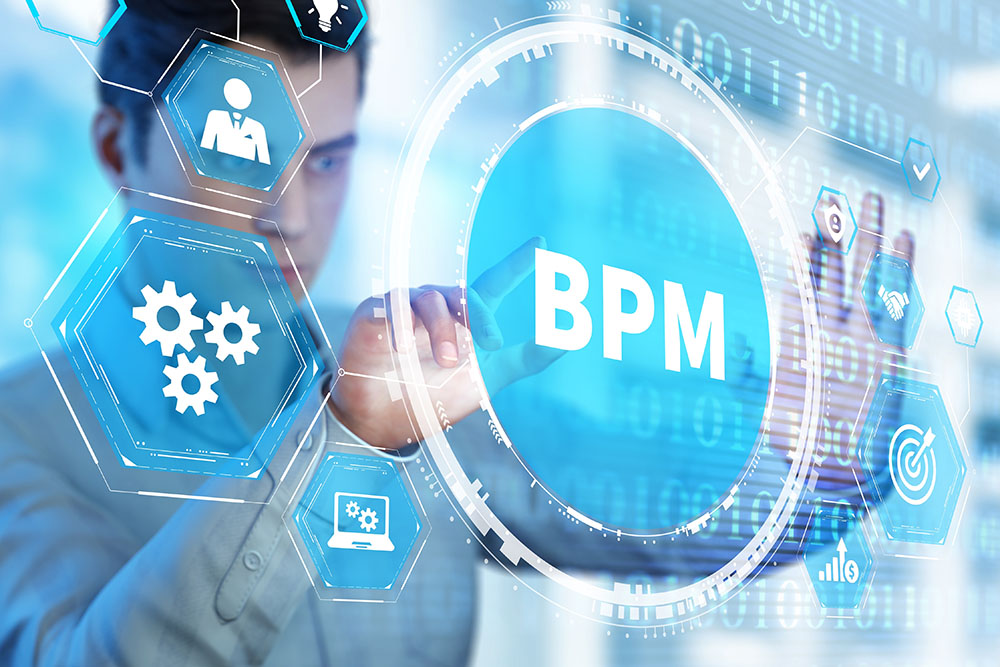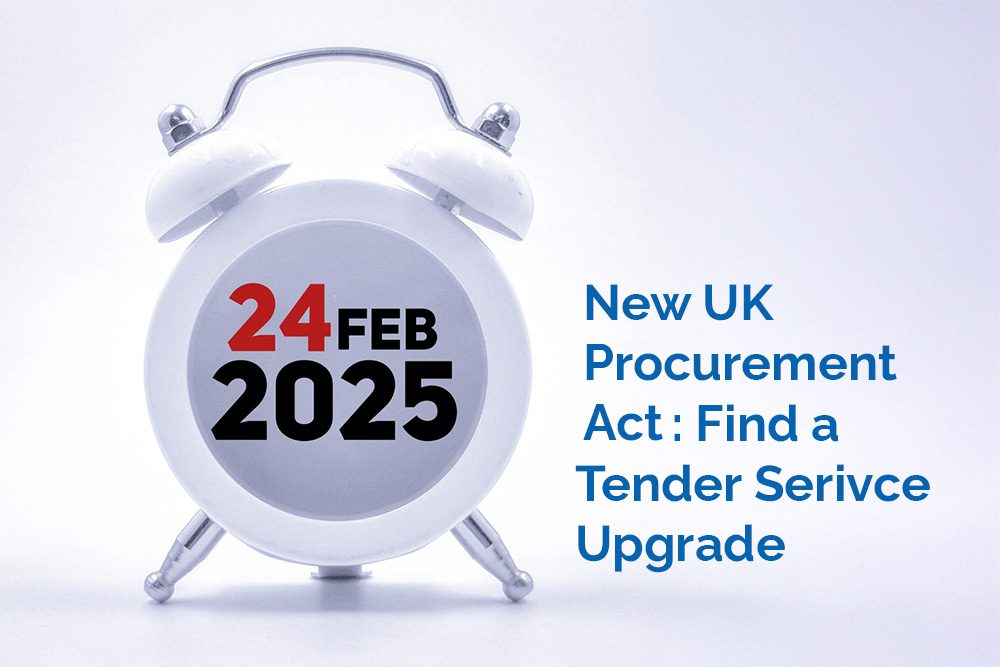Business Process Management (BPM) is a well-established model for improving business processes. It is well suited to being applied to tender management.
In this article we discuss how BPM offers a valuable approach to improving and streamlining your whole end-to-end bid journey. Plus we explore the six steps of BPM and highlight the benefits that can be achieved through implementation.
In Part 2 of this series, we will delve deeper into BPM and how TenderEyes software is an ideal BPM platform for improvement implementation.
Challenges in Tender Management
Bidding for high-value competitive tenders is a big challenge for any business. It requires huge investment in time, money and people. Inefficiencies in any stage of the tender process can severely hamper the quality of tender submissions and win rates.
Challenges include:
- Complexity and Volume: Managing multiple tenders simultaneously, each with its unique requirements, can overwhelm teams. This can lead to errors, oversights or rushed submissions. Focus on best-fit tenders may be lost in a ‘bid for everything’ strategy approach.
- Time Sensitivity: Tight deadlines necessitate swift action. However, delays or inefficiencies in the process leave little room to properly understand and respond to tender requirements. Leading to potential low scoring bids and lost contracts.
- Content Management: The volume and variety of information and documentation required to answer tender questions is huge. Valuable time and resources can be wasted sourcing, creating, reviewing and updating content. Tight deadlines may lead to inaccurate or expired content being used to create poor quality responses. In some cases Bid Teams may be forced to reuse previous low scoring responses.
- Coordination Issues: Required collaboration among different teams, divisions and geographies can be hindered by communication barriers. This can lead to misunderstandings or conflicts. And unfortunately result in low engagement or commitment by stakeholders to deliver their best efforts.
- Compliance and Risk Management: Ensuring regulations compliance and addressing potential bid risks requires thorough scrutiny and diligence. Decision making and review may become rushed due to time constraints, resulting in high-risk tenders being submitted and even won.
- Resource Allocation: Proper allocation of resources, including personnel, time, and finances, is essential to maximize the chances of winning lucrative contracts. But with many contributors having their own roles and responsibilities to contend with, tender activities may not be given high priority or the right amount of time to deliver high quality input.

Why BPM for Tender Management?
Business Process Management (BPM) is an established methodology for improving business processes. These are end-to-end processes that are repeatable, involve multiple projects, teams and departments and have the scope to be streamlined to increase working efficiencies and cost savings.
“Business process management (BPM), employs methods to discover, model, analyse, measure, improve and optimize business strategy and processes.” Gartner
There are 3 types of BPM that look at different aspects of process delivery:
- Integration-centric BPM: activities that require less human involvement and are more focused on review of technology and cross-platform processes and tasks.
- Human-centric BPM: processes requiring human thought and decision making such as task management, content creation and approvals.
- Document-centric BPM: focused on the management of content and documentation.

BPM offers an ideal framework for reviewing your bid management practices and processes. Each of the above 3 BPM approaches is relevant to and can be applied to the bid management process.
However, undertaking the integration-centric approach, will provide for a wider assessment and help address both the human-centric and document-centric challenges involved in tender management.
Implementing BPM for Tender Management
There are six steps to implementing Business Process Management within your business and are considered here in relation to the bid management.
1. Plan
It is essential to set your business objectives and goals for implementing BPM. In this instance, you may be looking to address falling tender win rates or shortfalls in financial targets.
Such changes in your business performance provide a strong catalyst for reviewing your end-to-end bid management process. Be clear about the goals you wish to achieve. This could include:
- Better targeting and pursuit of just your best-fit tenders
- Building stronger collaboration and commitment from contributors
- Generating and making accessible better quality and approved content
- Improving tender responses to secure higher evaluation scores.
Securing the full support of management and the whole business at this stage is essential to long-term success of your BPM project.
2. Design
The next stage is to map out your existing end-to-end bid management process. This requires looking at each stage of the bid journey, identifying manual and automated tasks, people involved, timelines and technologies used. It is essential to ascertain common roadblocks and delays as well as areas of repetitive manual activity, poor collaboration, or technological inefficiencies.
This may feel like a daunting process given the complexity of bid management but can be broken down into distinct areas of the bid journey as in the diagram below. Each stage can be allocated to different teams to ascertain existing activities and processes.

It will also be important to consider the time and activities required between bid stages. For example, handover of the tender opportunity to the bid team for bid creation, once the sales team has qualified and approved pursuit action. This can often result in unnecessary delays or limited sharing of project documentation or insights.
In mapping your existing processes, ensure you involve everybody undertaking the work. They will have the greatest knowledge on the reality of executing the work and the challenges involved. It will be vitally important to ensure these stakeholders do not feel threatened by the BPM process and are fully engaged in the improvement plan.
This full and detailed assessment of current procedures will then give you clear insights into areas of the bid process that need improving.
3. Model
It is then a matter of exploring ideas and designing the ‘ideal’ new bid management process. Involving all process stakeholders is critical at this stage to gain deeper understanding of the real practicalities involved in setting up new processes. This will also help secure early buy-in to the BPM process and final implementation success.
Creating visual representations (petri nets, Gantt and flow charts etc), detailed descriptions and desired outcomes of the new model will help stakeholders better understand and test the new process. Further insights will allow for additional finetuning of the model to ensure optimum efficiencies are achieved.
4. Execute
The end-to-end bid journey is a complex process with multiple teams, activities, tasks and content involved. Taking a phased approach to implementation will be essential.
Consider which stage of the bid journey needs the most improvement and identify the critical areas to automate activities and streamline workflows. Understanding where you can achieve the most gains to achieve your desired BPM goals will help you set priorities.
Establish an implementation team with clear roles and responsibilities for completion. Ensure you involve all stakeholders throughout the implementation stage, providing clear communication, training and support.
It will be essential to test your implementation process with a small group of stakeholders and discrete process improvements. Ensuring your approach works will then give you confidence to roll out the wider implementation plan to the wider team.
5. Monitor
It is essential to monitor the performance and outcomes of the new process model. Setting clear performance metrics that can be easily tracked and measured will help establish how well the new process is working. Having benchmark data from the old process to compare will also provide further insight. Consideration should be given to:
- Improved pursuit of best-fit tenders
- Reduction in repetitive manual work
- Reduced roadblocks and time delays
- Time saved in completing tasks
- Stronger collaboration and communication
- Better content management and use
- Improved approvals process
- Quality of tender submissions and win rates.
6. Optimise
These new insights will help you to further finetune your process and find new ways to greater working efficiencies and improvements. This is an ongoing process and should never be forgotten or set aside.
Both the internal and external environment may impact your implemented process model and should also be regularly reviewed. This may include structural, resource and business strategy updates as well as changing legislative, regulatory or industry demands.
A business that stays vigilant and addressing such changes through their bid management processes, maintains a competitive advantage over competitors who continue to rely on their existing practices.
Benefits of BPM for Tender Management
BPM offers a structured approach to addressing the challenges inherent in tender management. By leveraging BPM principles and methodologies, organisations can design, execute, monitor, and optimise their tender processes systematically.
“Business Process Management initiatives can result in productivity benefits of 30 to 50 percent.” Forrester
Here’s how BPM can enhance tender management:
- Process Standardisation: Enables tender processes to be implemented consistently and repeatedly across the entire bid journey and by all stakeholders. This helps minimise delays, ambiguities and errors in the delivery of your best-fit quality tender submissions.
- Content Generation and Management: Ensures tender related information and documentation is easily accessible, searchable, accurate, up-to-date and approved for use. Giving the Bid Teams confidence to compile business aligned quality tender responses.
- Automation and Integration: Helps streamline previous labour-intensive, repeatable tender management activities. Thus, freeing up valuable time for your Bid Team to focus on improving response quality and potential evaluation scores.
- Collaboration and Communication: Fosters better collaboration among cross-functional teams and content contributors, involved in tender management. Resulting in deeper engagement and commitment to deliver quality bids.
- Performance Monitoring and Analytics: Provides organisations with real-time visibility into their tender management processes. By tracking key performance indicators (KPIs), such as bid submission time, win rate, and resource utilisation, organisations can more easily identify roadblocks, inefficiencies, and areas for improvement.
- Compliance and Risk Management: Enables organisations to embed compliance checks and risk assessments into their tender processes. Thus, ensuring adherence to regulatory requirements and mitigating potential risks, such as legal liabilities or financial losses.
Conclusion
In an increasingly competitive business environment, effective tender management is essential for organisations to secure lucrative contracts and sustain growth.
By embracing Business Process Management (BPM), organisations can streamline their tender processes, enhance collaboration, mitigate risks, and improve overall performance.
Through process standardisation, automation, collaboration tools, performance monitoring, and analytics, BPM empowers businesses to optimize their tender strategies, stay ahead of the game and achieve greater success in the marketplace.
Look out for Part 2 of this series where we delve deeper into BPM benefits and look at how the TenderEyes software provides an ideal BPM platform for bid management.









